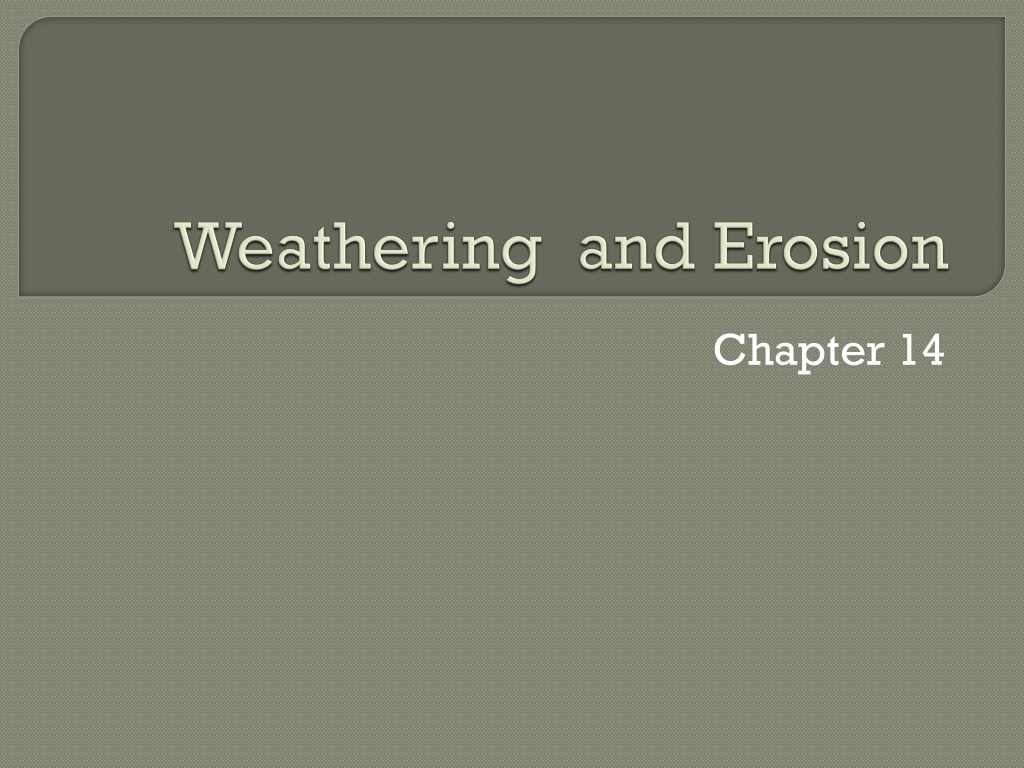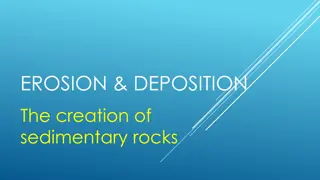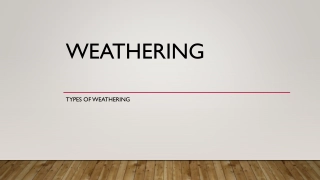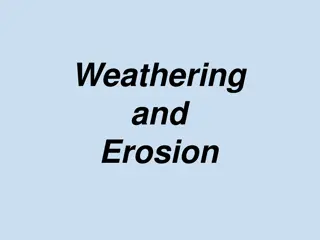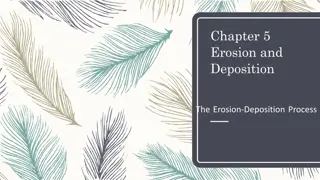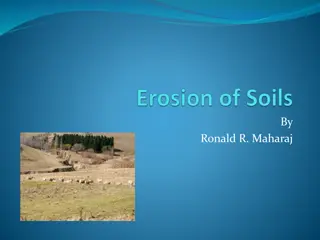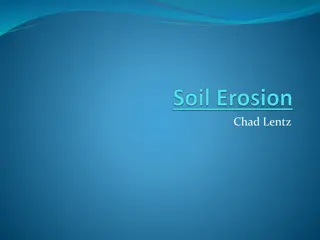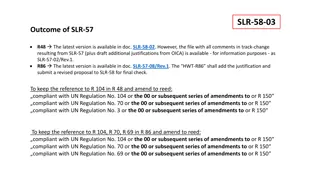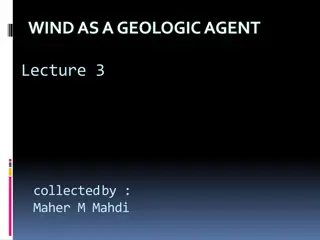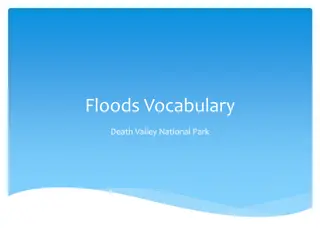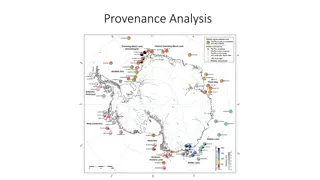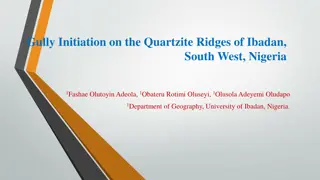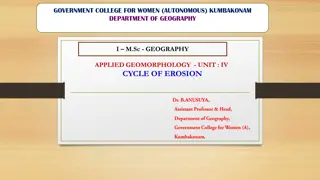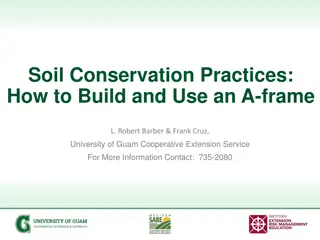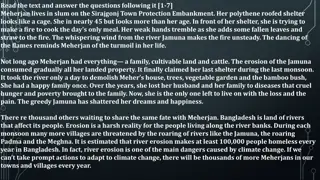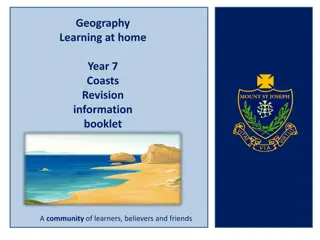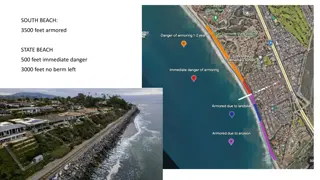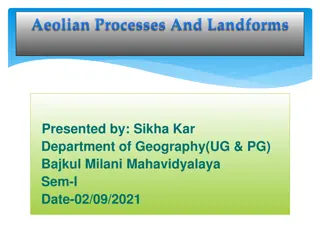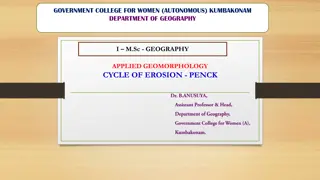Understanding Weathering and Erosion Processes in Chapter 14
Weathering and erosion are natural processes that break down rocks through mechanical and chemical means. Chapter 14 explores the different types of weathering processes, including mechanical weathering like ice wedging and abrasion, as well as chemical weathering from reactions with substances like water and acids. Organic activities from plants and animals also play a role in weathering, leading to changes in rock composition and appearance.
Download Presentation

Please find below an Image/Link to download the presentation.
The content on the website is provided AS IS for your information and personal use only. It may not be sold, licensed, or shared on other websites without obtaining consent from the author. Download presentation by click this link. If you encounter any issues during the download, it is possible that the publisher has removed the file from their server.
E N D
Presentation Transcript
Weathering and Erosion Chapter 14 Section 1 Weathering Processes Section 2 Rates of Weathering Section 3 Soil Section 4 Erosion
Section 1 Weathering Processes Chapter 14 weathering the natural process by which atmospheric and environmental agents, such as wind, rain, and temperature changes, disintegrate and decompose There are two main types of weathering processes mechanical weathering and chemical weathering. Each type of weathering has different effects on rock.
Section 1 Weathering Processes Chapter 14 mechanical weathering the process by which rocks break down into smaller pieces by physical means does not change the composition of the rock. Common agents of mechanical weathering are ice, plants and animals, gravity, running water, and wind.
Section 1 Weathering Processes Chapter 14 Ice Wedging Ice wedging occurs when water seeps into the cracks in rock and freezes. When the water freezes, its volume increases by about 10% and creates pressure on the surrounding rock. This process eventually splits the rock apart.
Section 1 Weathering Processes Chapter 14 Abrasion abrasion the grinding and wearing away of rock surfaces through the mechanical action of other rock or sand particles Abrasion is caused by gravity, running water, and wind.
Section 1 Weathering Processes Chapter 14 Organic Activity As plants grow, the roots grow and expand to create pressure that wedge rock apart. Earthworms and other animals that move soil expose new rock surfaces to both mechanical and chemical weathering.
Section 1 Weathering Processes Chapter 14 chemical weathering the process by which rocks break down as a result of chemical reactions Chemical reactions commonly occur between rock, water, carbon dioxide, oxygen, acids, and bases. Chemical weathering changes both the composition and physical appearance of the rock.
Section 1 Weathering Processes Chapter 14 Oxidation oxidation a reaction that moves one or more electrons from a substance such that the substance s valence or oxidation state increases; in geology, the process by which an element combines with oxygen Oxidation commonly occurs in rock that has iron-bearing minerals, such as hematite and magnetite.
Section 1 Weathering Processes Chapter 14 Oxidation, continued Iron, Fe, in rocks and soil combines quickly with oxygen, O2, that is dissolved in water to form rust, or iron oxide, Fe2O3. 4Fe + 3O2 2Fe2O3 The red color of much of the soil in the southeastern United States is due to mainly the presence of iron oxide produced by oxidation.
Section 1 Weathering Processes Chapter 14 Hydrolysis hydrolysis a chemical reaction between water and another substance to form two or more new substances Water plays a crucial role in chemical weathering. Minerals that are affected by hydrolysis often dissolve in water. Water can then carry the dissolved minerals to lower layers of rock in a process called leaching.
Section 1 Weathering Processes Chapter 14 Carbonation carbonation the conversion of a compound into a carbonate When carbon dioxide, CO2, from the air dissolves in water, H2O, a weak acid called carbonic acid, H2CO3, forms. H2O + CO2 H2CO3 Carbonic acid has a higher concentration of hydronium ions than pure water does, which speeds up the process of hydrolysis.
Section 1 Weathering Processes Chapter 14 Organic Acids Acids are produced naturally by certain living organisms. Lichens and mosses grow on rocks and produce weak acids that can weather the surface of the rock. The acids seep into the rock and produce cracks that eventually cause the rock to break apart.
Section 1 Weathering Processes Chapter 14 Acid Precipitation acid precipitation precipitation, such as rain, sleet, or snow, that contains a high concentration of acids, often because of the pollution of the atmosphere Acid precipitation weathers rock faster than ordinary precipitation does. Rainwater is slightly acidic because it combines with small amounts of carbon dioxide.
Section 1 Weathering Processes Chapter 14 Acid Precipitation, continued But when fossil fuels, especially coal, are burned, nitrogen oxides and sulfur dioxides are released into the air. These compounds combine with water in the atmosphere to produce nitric acid, nitrous acid, or sulfuric acid. The occurrence of acid precipitation has been greatly reduced since power plants have installed scrubbers that remove much of the sulfur dioxide before it can be released.
Section 2 Rates of Weathering Chapter 14 The processes of mechanical and chemical weathering generally work very slowly. The rate at which rock weathers depends on a number of factors, including rock composition, climate, and topography.
Section 2 Rates of Weathering Chapter 14 differential weathering the process by which softer, less weather resistant rocks wear away at a faster rate than harder, more weather resistant rocks do When igneous rocks that are rich in the mineral quartz are exposed on Earth s surface, they remain basically unchanged, even after all of the surrounding sedimentary rock has weathered away. They remain unchanged because the chemical composition and crystal structure of quartz make quartz resistant to chemical weathering.
Section 2 Rates of Weathering Chapter 14 Limestone and other sedimentary rocks that contain calcite are weathered most rapidly. They weather rapidly because they commonly undergo carbonation. Other sedimentary rocks are affected mainly by mechanical weathering processes. The rates at which these rocks weather depend mostly on the material that holds the sediment grains together. For example, shales and sandstones that are not firmly cemented together gradually break up to become clay and sand particles.
Section 2 Rates of Weathering Chapter 14 Surface Area Both chemical and mechanical weathering may split rock into a number of smaller rocks. The part of a rock that is exposed to air, water, and other agents of weathering is called the rock s surface area. As a rock breaks into smaller pieces, the surface area that is exposed increases.
Section 2 Rates of Weathering Chapter 14 Fractures and Joints Most rocks on Earth s surface contain natural fractures and joints. These structures are natural zones of weakness within the rock. Fractures and joints increase the surface area of a rock and allow weathering to take place more rapidly. They also form natural channels through which water flows.
Section 2 Rates of Weathering Chapter 14 In general, climates that have alternating periods of hot and cold weather allow the fastest rates of weathering. In warm, humid climates, chemical weathering is also fairly rapid. The constant moisture is highly destructive to exposed surfaces. The slowest rates of weathering occur in hot, dry climates. The lack of water limits many weathering processes, such as carbonation and ice wedging. Weathering is also slow in very cold climates.
Section 2 Rates of Weathering Chapter 14 Because temperatures are generally cold at high elevations, ice wedging is more common at high elevations than at low elevations. On steep slopes, such as mountainsides, weathered rock fragments are pulled downhill by gravity and washed out by heavy rains. As a result of the removal of these surface rocks, new surfaces of the mountain are continually exposed to weathering.
Section 2 Rates of Weathering Chapter 14 Mining and construction often expose rock surfaces to agents of weathering. Mining also often exposes rock to strong acids and other chemical compounds that are used in mining processes. Recreational activities such as hiking or riding all-terrain vehicles can also speed up weathering by exposing new rock surfaces. Rock that is disturbed or broken by human activities weathers more rapidly than undisturbed rock does.
Section 2 Rates of Weathering Chapter 14 Rock that is disturbed or broken by plants or animals also weathers more rapidly than undisturbed rock does. The roots of plants and trees often break apart rock. Burrowing animals dig holes into rock and soil. Some biological wastes of animals can cause chemical weathering.
Section 3 Soil Chapter 14 soil a loose mixture of rock fragments and organic material that can support the growth of vegetation One result of weathering is the formation of regolith, a layer of weathered rock fragments that covers much of Earth s surface. Bedrock is the solid, unweathered rock that lies beneath the regolith.
Section 3 Soil Chapter 14 The characteristics of soil depend mainly on the rock from which the soil was weathered, which is called the soil s parent rock. Soil Composition Soil composition refers to the materials of which it is made. The color of soil is related to the composition of the soil. Soil moisture can also affect color.
Section 3 Soil Chapter 14 Soil Texture Rock material in soil consists of three main types: clay, silt, and sand. Clay particles have a diameter of less than 0.004 mm. Silt particles have a diameter from 0.004 to 0.06 mm. Sand particles have diameters from 0.06 to 2mm. The proportion of clay, silt, and sand in soil depends on the soil s parent rock.
Section 3 Soil Chapter 14 soil profile a vertical section of soil that shows the layers of horizons horizon a horizontal layer of soil that can be distinguished from the layers above and below it; also a boundary between two rock layers that have different physical properties Transported soils are commonly deposited in unsorted masses. However, residual soils commonly develop distinct layers over time.
Section 3 Soil Chapter 14 humus dark, organic material formed in soil from the decayed remains of plants and animals Residual soils generally consist of three main horizons. The A horizon, or topsoil, is a mixture of organic materials and small rock particles. The B horizon or subsoil, contains the minerals leached from the topsoil, clay, and sometimes, humus. The C horizon consists of partially-weathered bedrock.
Section 3 Soil Chapter 14 The image below shows the soil horizons of residual soils.
Section 3 Soil Chapter 14 Climate is one of the most important factors that influences soil formation. Climate determines the weathering processes that occur in a region. These weathering processes, in turn, help determine the composition of soil.
Section 3 Soil Chapter 14 Tropical Soils In humid tropical climates, where much rain falls and where temperatures are high, chemical weathering causes thick soils to develop rapidly.
Section 3 Soil Chapter 14 Temperate Soils In temperate climates, where temperatures range between cool and warm and here rainfall is not excessive, both mechanical and chemical weathering occur. All three soil horizons in temperate soils may reach a thickness of several meters.
Section 3 Soil Chapter 14 Desert and Arctic Soils In desert and arctic climates, rainfall is minimal and chemical weathering occurs slowly. As a result, the soil is thin and consists mostly of regolith evidence that soil in these areas form mainly by mechanical weathering. Desert and arctic climates are also often too warm or too cold to sustain life, so their soils have little humus.
Section 3 Soil Chapter 14 Soil and Topography Because rainwater runs down slopes, much of the topsoil of the slope washes away. Therefore, the soil at the top and bottom of a slope tends to be thicker than the soil on the slope. Topsoil that remains on a slope is often too thin to support dense plant growth.
Section 4 Erosion Chapter 14 erosion a process in which the materials of Earth s surface are loosened, dissolved, or worn away and transported from one place to another by a natural agent, such as wind, water, ice, or gravity When rock weathers, the resulting rock particles do not always stay near the parent rock. Various forces may move weathered fragments of rock away from where the weathering occurred.
Section 4 Erosion Chapter 14 Ordinarily, new soil forms about as fast as existing soil erodes. Some farming and ranching practices increase soil erosion. Soil erosion is considered by some scientists to be the greatest environmental problem that faces the world today. This erosion prevents some countries from growing the crops needed to prevent widespread famine.
Section 4 Erosion Chapter 14 Results of Soil Erosion Constant erosion reduces the fertility of the soil be removing the A horizon, which contains the fertile humus. The B horizon, which does not contain much organic matter, is difficult to farm because it is much less fertile than the A horizon. Without plants, the B horizon has nothing to protect it from further erosion. So, within a few years, all the soil layers could be removed by continuous erosion.
Section 4 Erosion Chapter 14 Certain farming and grazing techniques and construction projects can also increase the rate of erosion. This land clearing removes protective ground cover plants and accelerates topsoil erosions. But rapid, destructive soil erosion can be prevented by soil conservation methods.
Section 4 Erosion Chapter 14 mass movement the movement of a large mass of sediment or a section of land down a slope Gravity causes rock fragments to move down inclines. Some mass movements occur rapidly, and others occur very slowly.
Section 4 Erosion Chapter 14 Rockfalls and Landslides The most dramatic and destructive mass movements occur rapidly. The fall of rock from a steep cliff is called a rockfall. A rockfall is the fastest kind of mass movement. When masses of loose rock combined with soil suddenly fall down a slope, the event is called a landslide. Heavy rainfall, spring thaws, volcanic eruptions, and earthquakes can trigger landslides.
Section 4 Erosion Chapter 14 Mudflows and Slumps The rapid movement of a large amount of mud creates a mudflow. Mudflows occur in dry, mountainous regions during sudden, heavy rainfall or as a result of volcanic eruptions. Mud churns and tumbles as it moves down slopes and through valleys, and it frequently spreads out in a large fan shape at the base of the slope.
Section 4 Erosion Chapter 14 Mudflows and Slumps, continued Sometimes, a large block of soil and rock becomes unstable and moves downhill in one piece. The block of soil then slides along the curved slope of the surface. This type of movement is called a slump. Slumping occurs along very steep slopes. Saturation by water and loss of friction within underlying rock causes loose soil to slip downhill over the solid rock.
Section 4 Erosion Chapter 14 Solifluction solifluction the slow, downslope flow of soil saturated with water in areas surrounding glaciers at high elevations Solifluction occurs in arctic and mountainous climates where the subsoil is permanently frozen. In the spring and summer, only the top layer of soil thaws. Solifluction can also occur in warmer regions, where the subsoil consists of hard clay.
Section 4 Erosion Chapter 14 Creep creep the slow downhill movement of weathered rock material Soil creep moves the most soil of all types of mass movements. But creep may go unnoticed unless buildings, fences, or other surface objects move along with the soil. Many factors contribute to soil creep.
Section 4 Erosion Chapter 14 landforms a physical feature of Earth s surface There are three major landforms that are shaped by weathering and erosion mountains, plains, and plateaus. Minor landforms include hills, valleys, and dunes. All landforms are subject to two opposing processes. One process bends, breaks and lifts Earth s crust and thus creates elevated, or uplifted, landforms. The other process is weathering and erosion, which wears down land surfaces.
Section 4 Erosion Chapter 14 Erosion of Mountains During the early stages in the history of a mountain, the mountain undergoes uplift. When the forces stop uplifting the mountain, weathering and erosion wear down the rugged peaks to rounded peaks and gentle slopes. Over millions of years, mountains that are not being uplifted become low, featureless surfaces. These areas are called peneplains, which means almost flat.
Section 4 Erosion Chapter 14 Erosion of Plains and Plateaus A plain is a relatively flat landform near sea level. A plateau is a broad, flat landform that has a high elevation. A plateau is subject to much more erosion than a plain. The effect of weathering and erosion on a plateau depends on the climate and the composition and structure of the rock.
Mudslide Video http://www.bing.com/videos/search?q=m udslide+video&mid=3AA0FCDA5795228E C6493AA0FCDA5795228EC649&view=det ail&FORM=VIRE5
